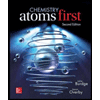
Concept explainers
(a)
Interpretation:
Product and the
Concept introduction:
Substitution reaction: During a chemical reaction when one functional group is transformed as another functional group in a chemical compound is called substitution reaction.
Nucleophilic Substitution reaction: electron rich nucleophile attacks the positive or partially positive charge of an atom and replace a leaving group is called Nucleophilic Substitution reaction.
Elimination reaction: An elimination reaction is removal of two substituents in a molecule and forms
(b)
Interpretation:
Addition reaction of ethylene should be identified.
Concept introduction:
Addition reaction: addition reaction is two or more molecules combine to form a larger one.
(c)
Interpretation:
Chemical reaction for the isomerization of acetone should be identified.
Concept introduction:
Isomerization: one molecule is transformed into another molecule with same molecular formula but different arrangement
Want to see the full answer?
Check out a sample textbook solution
Chapter 23 Solutions
Chemistry: Atoms First
- Write an equation for the reaction of chloroacetic acid (Ka=1.5103) with trimethylamine (Kb=5.9105) . Calculate the equilibrium constant for the reaction. If 0.10 M solutions of these two species are mixed, what will be their concentrations at equilibrium?arrow_forwardOne mole of an unknown hydrocarbon, compound C, in the presence of a platinum catalyst, adds 98.9 L of hydrogen, measured at 744 mm Hg and 22 degrees C , to form a saturated alkane which contains one ring. When one mole of compound C is reacted with ozone, followed by reduction with (CH3)2S , four moles of only one product was formed, whose condensed molecular formula is CHO -CHO. Give the structure of compound C. Explain your reasoningarrow_forwardDraw the structures for and give the names for each of the isomeric carbonyl compounds corresponding to C4H8O and suggest suitable reactions for distinguishing between themarrow_forward
- Draw and name the five cycloalkane structures of formula C5H10. Can any of these structures give rise to geometric (cis-trans) isomerism? If so, show the cis and trans stereoisomersarrow_forward(a) When a compound containing C, H, and O is completelycombusted in air, what reactant besides the hydrocarbonis involved in the reaction? (b) What products form in thisreaction? (c) What is the sum of the coefficients in the balancedchemical equation for the combustion of one mole ofacetone, C3H6O1l2, in air?arrow_forwardEnter the molecular formula for butane, C4H10?arrow_forward
- Name all unbranched ether and alcohol isomers with formula C5H12O, and write their structural formulas.arrow_forwardIf you used a bromine test to distinguish between hexane and 2-hexene, in which the red color of bromine persist?arrow_forwardWrite a condensed structural formula for a dihydroxy compound with the formula C3H8O2.arrow_forward
- draw the structure of all monobromo derivatives of pentane, C5H11Br, which contain a 4 carbon chainarrow_forwardWhich of the following structural features could be found in a compound with formula C7H12?arrow_forwardWrite the polymerization reaction in which acetylene (C2H2) produces polyacetylene. Show the structural formulae of the monomers and the polymer.arrow_forward
 Chemistry: Principles and ReactionsChemistryISBN:9781305079373Author:William L. Masterton, Cecile N. HurleyPublisher:Cengage Learning
Chemistry: Principles and ReactionsChemistryISBN:9781305079373Author:William L. Masterton, Cecile N. HurleyPublisher:Cengage Learning Chemistry: The Molecular ScienceChemistryISBN:9781285199047Author:John W. Moore, Conrad L. StanitskiPublisher:Cengage Learning
Chemistry: The Molecular ScienceChemistryISBN:9781285199047Author:John W. Moore, Conrad L. StanitskiPublisher:Cengage Learning Chemistry: Principles and PracticeChemistryISBN:9780534420123Author:Daniel L. Reger, Scott R. Goode, David W. Ball, Edward MercerPublisher:Cengage Learning
Chemistry: Principles and PracticeChemistryISBN:9780534420123Author:Daniel L. Reger, Scott R. Goode, David W. Ball, Edward MercerPublisher:Cengage Learning Macroscale and Microscale Organic ExperimentsChemistryISBN:9781305577190Author:Kenneth L. Williamson, Katherine M. MastersPublisher:Brooks Cole
Macroscale and Microscale Organic ExperimentsChemistryISBN:9781305577190Author:Kenneth L. Williamson, Katherine M. MastersPublisher:Brooks Cole



